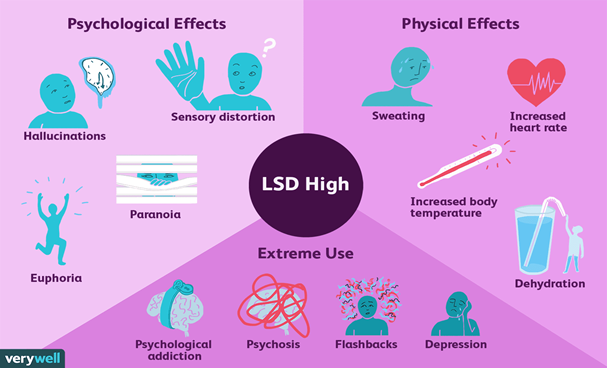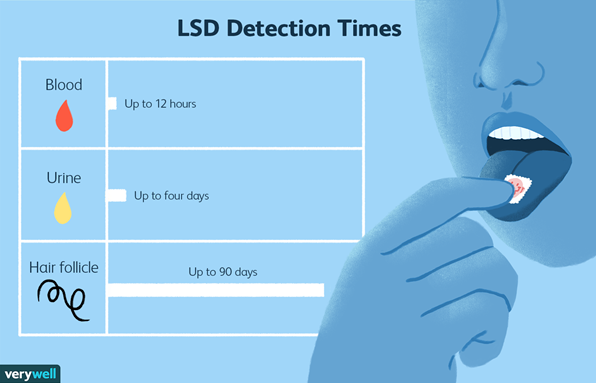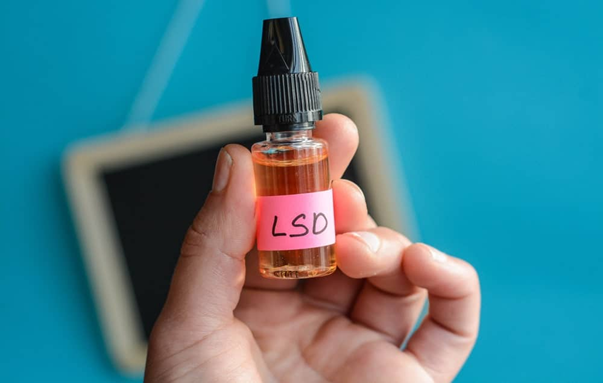LSD, or Lysergic Acid Diethylamide, is one of the most popular psychedelics that was synthesized for the first time in 1938 by Albert Hofmann. It was LSD that catalyzed the understanding of neurotransmitters and receptors, and also the development of other psychiatric drugs.
Clinical researchers investigated LSD as a treatment for a wide range of mental illnesses. They looked at obsession, anxiety, depression, and especially alcoholism and had a 50% success rate which is quite remarkable. Psychedelics including LSD have become a standard tool in psychotherapy.
The amount of LSD you consume determines how long it stays in your system. Usually, after taking a dose of LSD, it takes around 20 to 90 minutes for the effects to kick in. And then the effects may last up to eight hours.
Successful drug screenings will be able to detect the presence of LSD in your system, especially in the blood, hair, urine, or saliva. Now let’s learn about how long LSD stays in your system in a detailed manner.
What are the Effects of LSD and How Long Does it Take to Feel the Effects After Consumption?

Some of the well-known effects of LSD include:
- Nausea
- Dizziness
- Body tremors
- Hallucinations
- Increased heart rate and blood pressure
- Rise in body temperature leading to sweating
- Appetite loss
- Increased palpitation
- Euphoria
- Paranoia
All these effects seem to kick in almost within 20 to 90 minutes after the consumption of LSD either in the form of an oral pill or capsule or in a liquid form. The effects of an LSD trip can last up to 15 hours or even more, depending upon several factors which are discussed in the latter part.
Throughout the LSD trip, people tend to have rapid emotional mood swings and sensory distortions that keep changing from time to time. Sometimes, consuming a large dose of LSD can create panic in people and they might experience loss of control, despair, and terrifying hallucinations.
How Long Do the Effects of LSD Last in Your System?

After administering LSD to your system, the effects of a single dose of LSD can last up to 15 hours. The effects reach their peak levels after 4 hours of consumption but the continued feelings can last much longer. If consumed orally or sublingually, LSD gets absorbed in your body and enters the bloodstream at a much faster rate. It takes up to 24 hours for the liver to completely metabolize the drug, thus leading to the process of excretion.
Traces of LSD can be found in your system, especially in the blood, hair, and urine, while conducting a drug test. Let us take a look at how long LSD stays in your system and how LSD usually gets detected in blood, hair, or urine tests.
Blood
Research suggests that higher doses of LSD can be detected in your blood sample after 16 hours of its consumption whereas if low doses are consumed, it takes around 8 hours to detect the drug in your blood after its consumption. The detectability gradually decreases with time and almost ceases to exist after 16 hours. So you can see that the amount of LSD dose administered determines the duration of time it stays in your body. Usually, its traces can be found in the blood between 8 to 16 hours of consumption.
Hair
The traces of LSD start emerging in your hair from 5 to 15 days after its administration. It stays in your hair for about three months after it is administered. Usually, hair grows by 0.4 inches in a month, and hence in three months it will grow by 1.2 inches. This new growth of hair will verify the use of LSD in the past three months. Previous drug screenings suggest that hair follicle for LSD detection is not a reliable and common method of drug test. Only 12% of these tests conducted till now have given accurate results. This is because LSD traces exist in the hair in low concentrations.
Urine
After the passage of one day, 99% of LSD exists in the body in the form of inactive compounds known as metabolites, after the breakdown process in the liver. Detection of LSD in urine samples can occur within 5 days after its administration. Among all kinds of tests for LSD detection, urine tests are the most preferred and most reliable method for drug screenings. LSD detection in urine lab tests is time-consuming and does not yield instant results. Many times, urine tests fail to detect LSD in your urine.
There are some medicines that can yield false-positive results for drug tests, which include Buspirone, Fluoxetine, Labetalol, Verelan, Amitriptyline, Sertraline, etc. This is why positive LSD results need critical evaluation to check whether they are real or staged.
Factors that Determine the Duration of the Effects Lasting in Your System

Age
Age is one of the factors that determine how long LSD stays in your system. The rate of absorption of LSD in your body and the rate of metabolization of LSD by the liver occurs at a faster rate in young people than people who are above the age of 65. This is because the liver functioning and metabolism rate in young people is much better and faster than in older people.
Composition of the Body
The composition of your body which includes your height, weight, the water content in the body, body fat, and muscles also determine how long the LSD is going to stay in your body. A person with more body fat will have more metabolites in the body. The water content of your body is also a deciding factor in diluting the acid. If your body has more water content, the acid LSD will be diluted much faster.
Functioning of the Liver
How well your liver functions is yet another factor that determines the duration of LSD effects lasting in your system. After the administration of LSD, the liver carries out the main function of metabolism that breaks down the LSD into small molecules known as metabolites. This decreases their detection potential. Hence, the traces of LSD might exist longer in people suffering from certain medical conditions like liver dysfunction or liver impairment.
The Rate of Metabolism
The longevity of LSD effects and traces in your body all comes down to the rate of metabolism in the body. People who metabolize at a faster rate will absorb the drug more rapidly than people who metabolize at a slower rate. A faster rate of metabolism leads to the faster excretion of the acid.
Dose of the Drug

The amount of LSD you administer into your system is a prime factor that decides how long the drug is going to stay in your body. If you take higher doses of LSD such as 200 mcg, it will be prone to detection for a longer period compared to the consumption of smaller doses of LSD such as 100 mcg. It also depends on how often you do it.
There are several ways to eliminate the drug quickly from your body such as, keeping yourself hydrated before and after the consumption of LSD, refrain from administering it sooner before a drug detection test, and start exercising or working out to boost the rate of metabolism in your body. And in case you’re worried about the effects of LSD, don’t think twice and put an end to consuming it.
